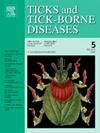Seasonal activity patterns of Ixodes scapularis and Ixodes pacificus in the United States
IF 3.4
2区 医学
Q2 INFECTIOUS DISEASES
引用次数: 0
Abstract
Knowledge of seasonal activity patterns of human-biting life stages of tick species serving as vectors of human disease agents provides basic information on when during the year humans are most at risk for tick bites and tick-borne diseases. Although there is a wealth of published information on seasonal activity patterns of Ixodes scapularis and Ixodes pacificus in the United States, a critical review of the literature for these important tick vectors is lacking. The aims of this paper were to: (i) review what is known about the seasonal activity patterns of I. scapularis and I. pacificus in different parts of their geographic ranges in the US, (ii) provide a synthesis of the main findings, and (iii) outline key knowledge gaps and methodological pitfalls that limit our understanding of variability in seasonal activity patterns. Based on ticks collected while questing or from wild animals, the seasonal activity patterns were found to be similar for I. pacificus in the Far West and I. scapularis in the Southeast, with synchronous activity of larvae and nymphs, peaking in spring (April to June) in the Far West and from spring to early summer (April to July) in the Southeast, and continuous activity of adults from fall through winter and spring with peak activity from fall through winter (November/December to March). In the colder climates of the Upper Midwest and Northeast, I. scapularis adults have a bimodal seasonal pattern, with activity peaks in fall (October to November) and spring (April to May). The seasonal activity patterns for immatures differ between the Upper Midwest, synchronous for larvae and nymphs with peak activity in spring and summer (May to August), and the Northeast, where the peak activity of nymphs in spring and early summer (May to July) precedes that of larvae in summer (July to September). Seasonality of human tick encounters also is influenced by changes over the year in the level of outdoor activities in tick habitat. Studies on the seasonality of ticks infesting humans have primarily focused on the coastal Northeast and the Pacific Coast states, with fewer studies in the Southeast, inland parts of the Northeast, and the Upper Midwest. Discrepancies between seasonal patterns for peak tick questing activity and peak human infestation appear to occur primarily for the adult stages of I. scapularis and I. pacificus. Study design and data presentation limitations of the published literature are discussed. Scarcity of data for seasonal activity patterns of I. pacificus outside of California and for I. scapularis from parts of the Southeast, Northeast, and Upper Midwest is a key knowledge gap. In addition to informing the public of when during the year the risk for tick bites is greatest, high-quality studies describing current seasonal activity patterns also will generate the data needed for robust model-based projections of future climate-driven change in the seasonal activity patterns and provide the baseline needed to empirically determine in the future if the projections were accurate.
美国肩胛冰蜱和太平洋冰蜱的季节活动模式
了解作为人类疾病媒介的蜱类叮咬人类生命阶段的季节性活动模式,可提供关于一年中人类在什么时候最容易受到蜱叮咬和蜱传疾病的基本信息。尽管在美国有大量关于肩胛硬蜱和太平洋硬蜱季节性活动模式的出版信息,但缺乏对这些重要蜱虫媒介的批判性文献综述。本文的目的是:(i)回顾在美国不同地理范围内,肩胛骨和太平洋棘足鼠的季节性活动模式的已知情况,(ii)提供主要研究结果的综合,(iii)概述限制我们理解季节性活动模式变化的关键知识差距和方法缺陷。基于蜱虫从野生动物,收集在探索或季节性活动模式被发现是相似的。马面在遥远的西部和i scapularis东南部,与同步活动的幼虫和蛹,峰值在春天(4月至6月)在遥远的西方,从春天到初夏(4月至7月)在东南,和连续活动的成年人从秋季到冬季和春季高峰活动从秋季到冬季(11月/ 12月至3月)。在较冷的中西部北部和东北部地区,肩胛骨成虫呈双峰季节性,活动高峰在秋季(10 - 11月)和春季(4 - 5月)。东北地区幼虫和若虫的活动高峰在春季和夏季(5 ~ 8月),而若虫的活动高峰在春季和初夏(5 ~ 7月),而幼虫的活动高峰在夏季(7 ~ 9月)之前。人类蜱虫遭遇的季节性也受到蜱虫栖息地一年中户外活动水平变化的影响。关于蜱虫侵袭人类的季节性研究主要集中在东北部沿海地区和太平洋沿岸各州,而在东南部、东北部内陆地区和中西部上游地区的研究较少。蜱虫搜寻活动高峰和人类侵扰高峰的季节模式差异似乎主要出现在肩胛骨恙虫和太平洋恙虫的成虫阶段。讨论了已发表文献的研究设计和数据呈现的局限性。缺乏加利福尼亚以外的太平洋蠓和东南部、东北部和中西部上游的肩胛蠓的季节性活动模式数据是一个关键的知识空白。除了告知公众一年中蜱虫叮咬风险最大的时间外,描述当前季节性活动模式的高质量研究还将产生对未来季节性活动模式中气候驱动变化的可靠模型预测所需的数据,并提供经验判断未来预测是否准确所需的基线。
本文章由计算机程序翻译,如有差异,请以英文原文为准。
求助全文
约1分钟内获得全文
求助全文
来源期刊

Ticks and Tick-borne Diseases
INFECTIOUS DISEASES-MICROBIOLOGY
CiteScore
6.90
自引率
12.50%
发文量
185
审稿时长
6-12 weeks
期刊介绍:
Ticks and Tick-borne Diseases is an international, peer-reviewed scientific journal. It publishes original research papers, short communications, state-of-the-art mini-reviews, letters to the editor, clinical-case studies, announcements of pertinent international meetings, and editorials.
The journal covers a broad spectrum and brings together various disciplines, for example, zoology, microbiology, molecular biology, genetics, mathematical modelling, veterinary and human medicine. Multidisciplinary approaches and the use of conventional and novel methods/methodologies (in the field and in the laboratory) are crucial for deeper understanding of the natural processes and human behaviour/activities that result in human or animal diseases and in economic effects of ticks and tick-borne pathogens. Such understanding is essential for management of tick populations and tick-borne diseases in an effective and environmentally acceptable manner.
 求助内容:
求助内容: 应助结果提醒方式:
应助结果提醒方式:


